 MORGANITE, the pink variety of beryl
MORGANITE, the pink variety of beryl
VARIETY INFORMATION:
- VARIETY OF: Beryl , Be3 Al2 Si6 O18 .
- USES: Gemstone.
- COLOR: various shades of pink.
- INDEX OF REFRACTION: 1.57 - 1.60
- BIREFRINGENCE: 0.004 - 0.008
- HARDNESS: 7.5 - 8
- CLEAVAGE: one direction, poor.
- CRYSTAL SYSTEM: hexagonal
- Pleochroic: weak
SPECIMENS
Morganite is the pink variety of beryl, the "mother of gemstones". While there are other pink gemstones (rose quartz and tourmaline come to mind), morganite is the most durable and rarest. It is quite unusual to find morganite jewelry, making those quite valuable.
Other gemstone color varieties that belong to beryl include emerald, heliodor, and aquamarine. Other colors of beryl are simply referred to by their color, such as red beryl.
Morganite is colored by trace amounts of manganese that find their way into the crystal structure. It is named after J.P. Morgan, a famous American industrialist. Morganite is found in China, Brazil, Madagascar, and California, Maine, Connecticut, and North Carolina in the U.S.
 Amethyst Galleries' Mineral Gallery MINERALS |
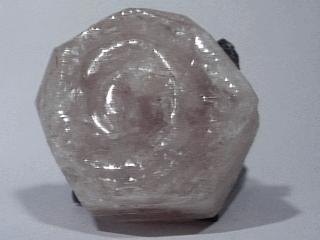
MORGANITE specimen mor-1
$ 100.00
$ 100.00
Dims: 1.9" x 1.8" x 0.9"(4.8 x 4.6 x 2.3 cm)
Wt: 2.45 oz.(69.6 g)
Morro Vecho, Minas Gerais, Brazil
This specimen simply consists of a section of a large crystal of Morganite, the pink variety of beryl. Even though one could hardly call it complete, this portion of the crystal includes the termination. It occurs in the hexagonal prismatic coulumnar form that is standard for beryl, and the termination consists of one large basal face truncated by six angled secondary faces, one of which is heavily damaged, and one of which is very tiny. The basal face has a very interesting pattern on it, reminiscent of a "whorl", or spiral that emanates from the face's center. The whorl has a depression that runs alongside of it, following the pattern outward. I have not seen a pattern like this before, on beryl, or any other crystal. The crystal is colored a moderate pink that is rather deep, I think, for Morganite, and it has a pearly to waxy luster. It is definitely translucent, though there are a few small patches of clarity amidst the heavy internal fracturing and cloudy inclusions. There are a few pieces of schorl tourmaline, including one complete but damaged crystal, attached to the Morganite, and a powdery pale tan substance in some of the crevices where the beryl was separated(it feels like a polishing compound).
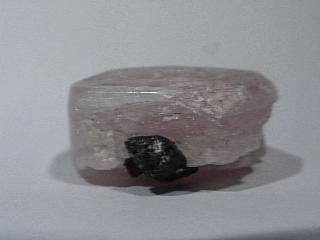

mor-1 ($100.00)
Morro Vecho, Minas Gerais, Brazil
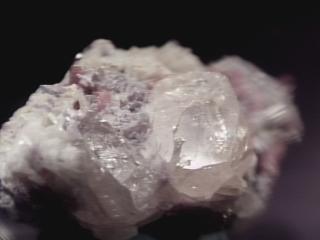
$ 300.00
Dims: 2.4" x 1.4" x 1.3" (6.1 x 3.6 x 3.3 cm)
Wt: 2.82 oz. (79.9 g)
Stewart Mine, Pala, California, U.S.A.
This small hand specimen consists of a complete, intact pale pink Morganite crystal erupting from a host rock consisting of albite, muscovite, quartz, and lepidolite, suffused with rubellite tourmaline crystals. The Morganite has visible dimensions of 0.6 x 0.6 x 0.4" (1.5 x 1.5 x 1.0 cm), and has excellent hexagonal prismatic form and a basal termination that is truncated by a few secondary faces. One of the faces appears to be damaged, but it is merely malformed due to the presence of another crystal that was tangent to it and since removed. It has well-defined edges and clean faces, some of which show a vitreous luster. A few of them show a duller, pearly-to-waxy luster. The crystal is transparent and quite clear, though it is heavily internally fractured and appears to be rather delicate. There are several rubellite tourmalines that accompany it; many of these are surprisingly undamaged! They tend to have a deep raspberry-red color and are transparent, clear, and only moderately internally fractured. I think that they really add to the specimen!
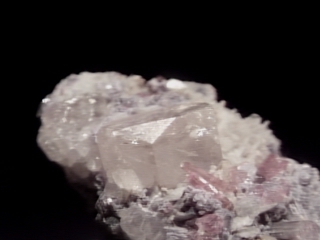

Stewart Mine, Pala, California, U.S.A.
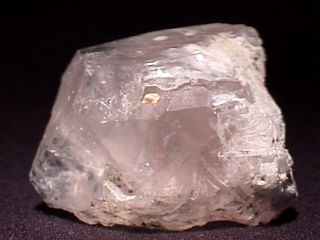
MORGANITE specimen mor-3
$ 70.00
$ 70.00
Dims: 1.7" x 1.4" x 1.2" (4.3 x 3.6 x 3.0 cm)
Wt: 1.73 oz. (49.2 g)
Stewart Mine, Pala, California, U.S.A.
This small specimen consists of part of a Morganite crystal. It is difficult to align the specimen so as to determine which visible face represents the primary termination face, or if it is even present. It shows considerable damage in the form of one large breakage surface, but what form is intact is good, showing well-defined edges and flat faces whose luster ranges from pearly to vitreous. It has a pale pink coloration and is transparent and quite clear, though there are very many internal fractures and flaws to block one's view. There is a hexagonal hole in one of the faces that extends completely through the piece and is visible from several of the other faces (see the close-up image). It is filled with a cream-colored material that is deceptively hard, but may have originally contained a large rutile crystal that has mostly moldered away. There are several broken bits of albite embedded in the piece that have spoiled the crystal's formation where they made contact.
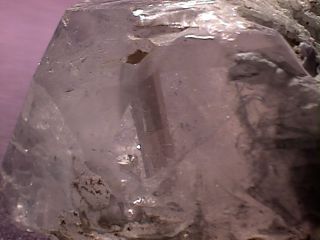

mor-3 ($ 70.00)
Stewart Mine, Pala, California, U.S.A.
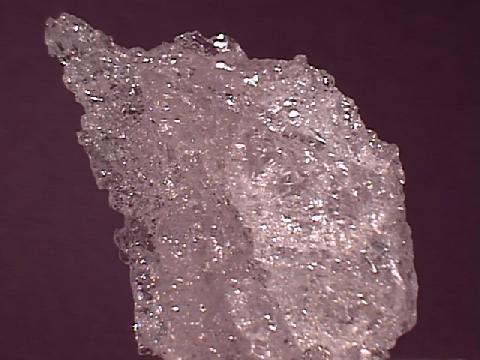
MORGANITE specimen mor-4
$ 65.00
$ 65.00
Dims: 1.8" x 1.5" x 1.1" (4.6 x 3.8 x 2.8 cm)
Wt: 1.42 oz. (40.5 g)
Conselheiro Pena, Minas Gerais, Brazil
This large thumbnail specimen is one that I find extremely attractive. It has an extremely warped hexagonal form that is similar to that of the goshenite specimen GOS-1. However, it is intact and shows almost no evidence of human-induced damage. It seems that every face has noticeable curvature, and there is not a straight edge present on the piece. It is almost as if a completely formless shard of a broken crystal underwent massive healing! The specimen has a very subtle, pale pink coloration and a vitreous luster, and is transparent and very clear, though there are a few internal flaws visible though the largest faces. The abnormal form of this specimen is a trait that I find most attractive.
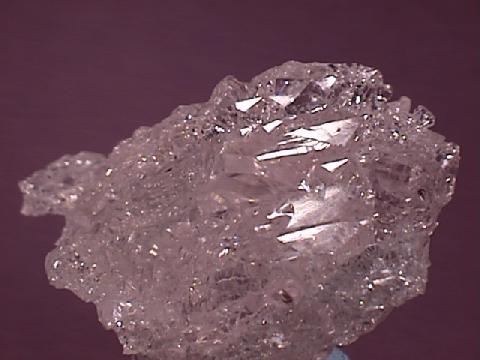

mor-4 ($ 65.00)
Conselheiro Pena, Minas Gerais, Brazil
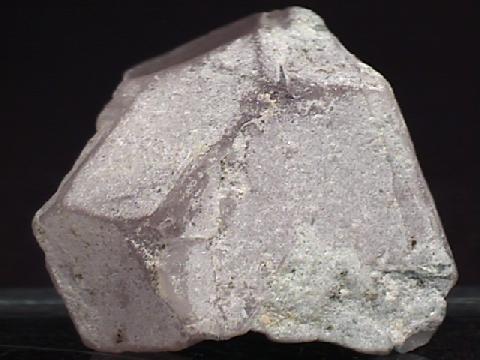
MORGANITE specimen mor-5
$ 32.00
$ 32.00
Dims: 1.1" x 1.0" x 0.6" (2.8 x 2.5 x 1.5 cm)
Wt: 12.3 g
Kunar Valley, Afghanistan
A single piece of an incomplete crystal constitutes this specimen. It seems to be a piece that broke off of a larger crystal and then partially healed, and then broke again, possibly during its mining. There are several incomplete, obviously crystalline faces which are covered with a thin crust of a dull, white substance. However, one of the faces has no covering on it, and is smooth and clean, showing a vitreous luster. One can see through it into the specimen, and most of its interior is visible from this vantage point. The material has a moderate pink color and is transparent and partially clear, though there are many inclusions and internal fractures. One surface on the piece's "underside" is also rather smooth, showing small growth patterns on it. I believe that this surface corresponded to a basal-oriented internal fracture where the piece separated from the rest of the crystal. A substantial portion of its surface is quite uneven, though, representing fresh breakage. A few pieces of bicolored elbaite are present. One of these pieces has a very odd, conical shape, and close examination shows a definite crystal form! I have not seen any tourmaline with a form like this before.
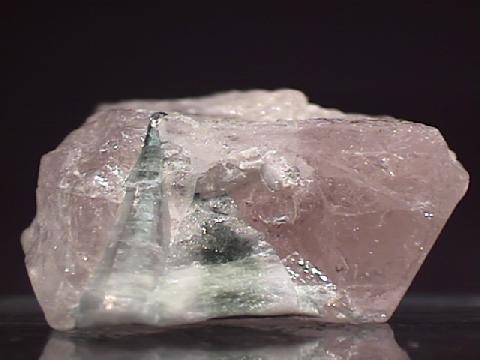

mor-5 ($ 32.00)
Kunar Valley, Afghanistan
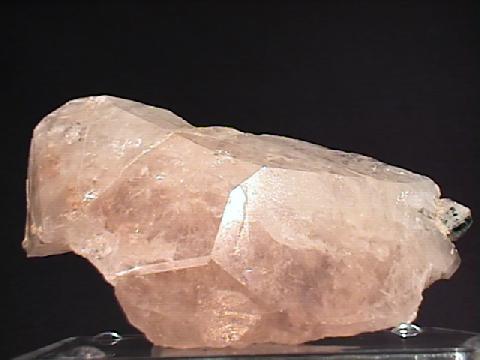
MORGANITE specimen mor-6
$ 80.00
$ 80.00
Dims: 3.6" x 1.8" x 1.6" (9.1 x 4.6 x 4.1 cm)
Wt: 6.02 oz. (170.7 g)
Stewart Mine, Pala, California, U.S.A.
This piece represents a portion of a very large Morganite crysal's termination that probably broke off during its mining. The specimen shows a few incomplete secondary termination faces, a few tiny parts of 2 prism faces, and a small portion of the main, basal termination face. All of these faces are smooth and show a rather dull pearly-to-vitreous luster, except for the basal face, which is pockmarked with growth patterns and has a brighter, vitreous luster. Part of this specimen has been broken off and repaired, though this is visible only through very close examination. Most of its surface is uneven due to the heavy breakage. It has a pale pink color with a hint of orange and is transparent, though it is so heavily included and internally fractured that one cannot see completely through it at any point. There is a tiny piece of bi-colored elbaite intergrown at one edge.
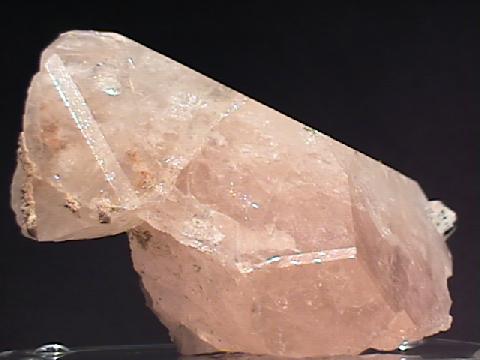

mor-6 ($ 80.00)
Stewart Mine, Pala, California, U.S.A.
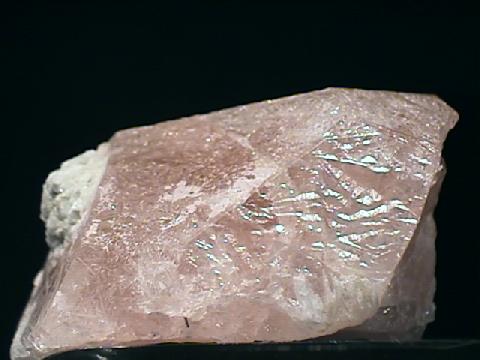
MORGANITE specimen mor-8
$ 60.00
$ 60.00
Dims: 1.8" x 1.7" x 1.1" (4.6 x 4.3 x 2.8 cm)
Wt: 2.26 oz. (64.2 g)
Stewart Mine, Pala, California, U.S.A.
A portion of a large, almost tabular hexagonal Morganite crystal consititutes this specimen. It consists merely of one corner and portions of the two adjacent prism faces. There is also one complete secondary termination face present, as well as small portions of two others, and a bit of the primary. All of these faces are smooth and relatively clean, but show odd, subtle growth markings that look like random straight lines. Most of these show a bright pearly luster, but the portion of the primary termination face that is present has a brighter, vitreous luster and thicker linear markings. The piece has a moderately pale pink color that shows traces of orange, and is transparent but heavily internally-fractured. There are a few patches of crystalline albite present; it most likely served as a base for the crystal.
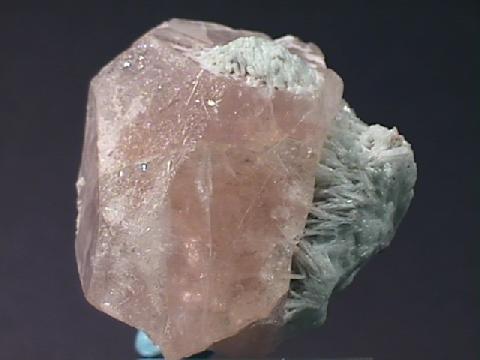

mor-8 ($ 60.00)
Stewart Mine, Pala, California, U.S.A.
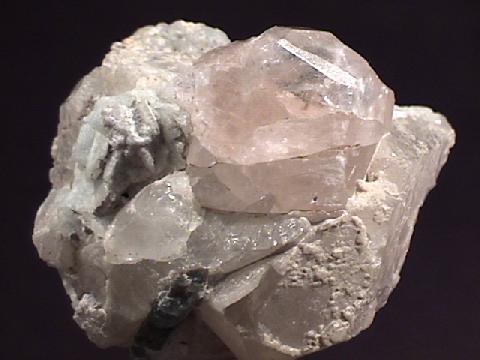
MORGANITE specimen mor-10
$ 100.00
$ 100.00
Dims: 2.4" x 2.2" x 1.9" (6.1 x 5.6 x 4.8 cm)
Wt: 5.74 oz. (164.2 g)
Stewart Mine, Pala, California, U.S.A.
A single, large Morganite crystal rests in the quartz/albite host of this hand specimen. The crystal has dimensions of 1.3 x 1.0 x 0.9" (3.3 x 2.5 x 2.3 cm) and is incomplete due to substantial damage to its exposed termination. It shows reasonably good hexagonal prismatic form, otherwise, and one can more or less make out its flattened hexagonal cross-section amid the damage. Its visible edges are straight and well-defined and its faces are smooth and show a luster that ranges from vitreous to almost waxy. The breakage surfaces also have a vitreous luster and show the conchoidal texture that one expects from this material. The crystal has a pale pink coloration and is transparent and very clear, though it contains many internal fractures. A natural fissure extends down into the crystal along its length, and bits of black tourmaline rest at its bottom. More of this tourmaline is partly embedded in the albite that makes up part of the host material; it shows almost no crystal form. Elsewhere on the host rock is embedded a 1" (2.5 cm)-long section of a greenish-blue crystal with a hexagonal prismatic form. It could possibly be an aquamarine, but I am relatively certain that it is an elbaite. At least 2 of its prism faces are exposed, and it shows a noticeable vitreous luster and patches of transparence. It was broken into sections and "cemented" back together prior to the specimen's mining. The quartz that contributes to the host material shows a noticeable crystal form in some areas, but is damaged and incomplete.
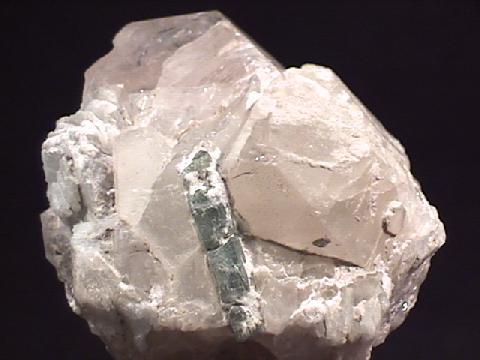

mor-10 ($100.00)
Stewart Mine, Pala, California, U.S.A.
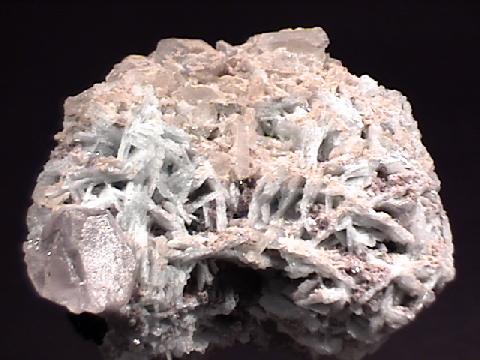
MORGANITE specimen mor-11
$ 70.00
$ 70.00
Dims: 2.3" x 2.2" x 1.9" (5.8 x 5.6 x 4.8 cm)
Wt: 5.35 oz. (151.7 g)
Stewart Mine, Pala, California, U.S.A.
This small hand specimen consists of an incomplete Morganite crystal that is partially embedded in an albite crust. The crystal has dimensions of 0.6 x 0.6 x 0.5" (1.5 x 1.5 x 1.3 cm) and shows a warped but discernable hexagonal prismatic form with a breakage area that is the only remains of the missing termination. At least 2 of the crystal's prism faces are also missing, but this is due to the fact that it grew adjacent and parallel to a broken schorl crystal; their close proximity affected both of them, for their adjacent faces are both malformed. Close examination of the Morganite shows that a very small amount of the basal face is still there, as well as a natural crevice that extended down through the termination and must have contributed to its malformation. Its color is a uniform pale pink and its luster is vitreous on the remnant of its termination face, whereas all the other natural faces and surfaces show a dull, waxy luster. It is transparent and quite clear, although a few substantial cloudy inclusions are visible. The adjacent schorl crystal is broken right at its base, so that only a tiny portion of two of its prism faces are visible. It has the standard black color, vitreous luster, and complete opacity. The albite base is made up of scores of intergrown blades, most of which show at least some damage. There are several more broken sections of schorl crystals embedded elsewhere in the albite, along with a few incomplete smoky quartz crystals that show only a small amount of their hexagonal prismatic form. A few tiny elbaites and a smattering of lepidolite rest in the spaces between the albite blades.
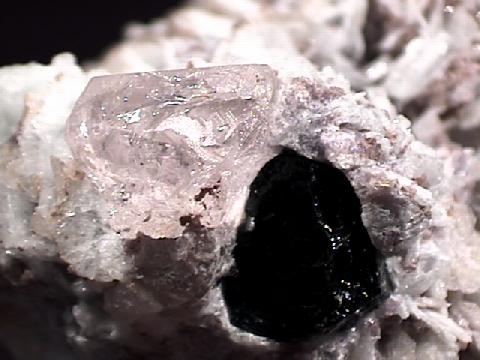

mor-11 ($ 70.00)
Stewart Mine, Pala, California, U.S.A.
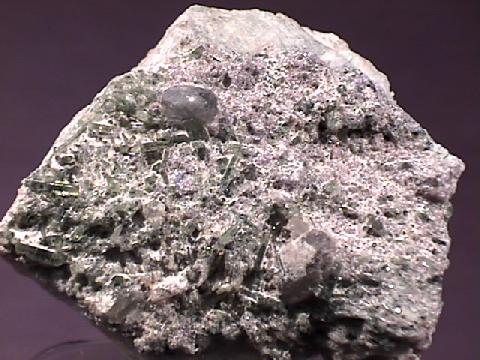
MORGANITE specimen mor-12
$ 35.00
$ 35.00
Dims: 2.1" x 1.7" x 1.5" (5.3 x 4.3 x 3.8 cm)
Wt: 3.82 oz. (108.3 g)
Stewart Mine, Pala, California, U.S.A.
One or two very small Morganite crystals rest on this specimen. They do not exceed 0.3" (8mm) in any dimension and are in very good condition. The largest crystal is partially embedded in the pegmatite host rock, and about half of it is exposed (see the close-up image). It is on its side, so that both of its basal terminations are partially visible. It shows excellent hexagonal form, though its dimensions suggest that it is more tabular than prismatic in its habit. It is nearly colorless, and so could almost be considered a goshenite. Its exposed faces are well-formed but show an unusually dull pearly-to-waxy luster. It appears to be transparent and quite clear, though a white inclusion is visible just under the surface of the topmost prism face. There is also a small elbaite crystal whose termination is partly intergrown with the Morganite, and very many others scattered on the host's face around it. These have a moderate green coloration and show reasonably good trigonal prismatic form, though their small size makes them somewhat difficult to study. There also seems to be evidence of some lepidolite on the face, though whatever crystals that are present are definitely microscopic in size! There are a few random smatterings of minerals elsewhere on the pegmatite base's surface, but these are broken and small, and almost impossible to identify by sight.
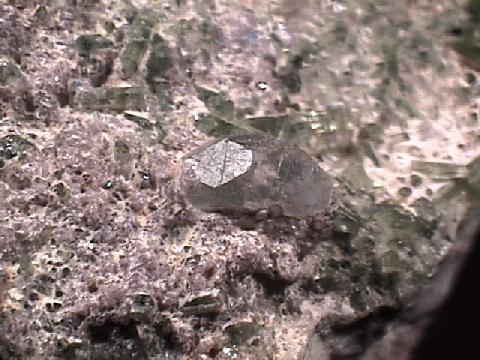

mor-12 ($ 35.00)
Stewart Mine, Pala, California, U.S.A.
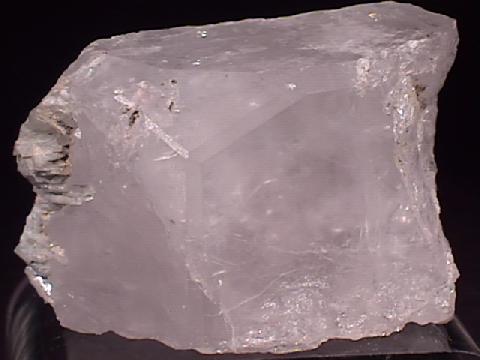
MORGANITE specimen mor-13
$ 55.00
$ 55.00
Dims: 2.0" x 1.3" x 0.9" (5.1 x 3.3 x 2.3 cm)
Wt: 2.62 oz. (74.2 g)
Stewart Mine, Pala, California, U.S.A.
This large thumbnail specimen consists of part of a single Morganite crystal. Even without the considerable breakage that is present, the crystal would not be complete due to the fact that it grew adjacent to the albite/pegmatite host rock and could not form completely, anyway. Thus, the only complete face that is present on this piece is a triangular secondary termination face that truncates the incomplete basal face. There are two smaller tertiary termaination faces adjacent to the secondary, but these are also incomplete. Two extremely thin but complete faces run between the secondary face and the two adjacent prism faces (which are also incomplete), which are in turn separated by another incomplete, thin face. All edges are straight and well-defined and all faces are clean and smooth. The main termination face is the only one that shows a vitreous luster; the rest are surprisingly dull, showing a pearly-to-vitreous luster at best. The surface that was adjacent to the host rock is flat but uneven and is coated with a thin crust that is likely made of albite. The crystal has a pale pink coloration and is transparent and partially clear, though it contains many internal fractures and flaws. There is only a small amount of crystalline albite present on the piece.

mor-13 ($ 55.00)
Stewart Mine, Pala, California, U.S.A.
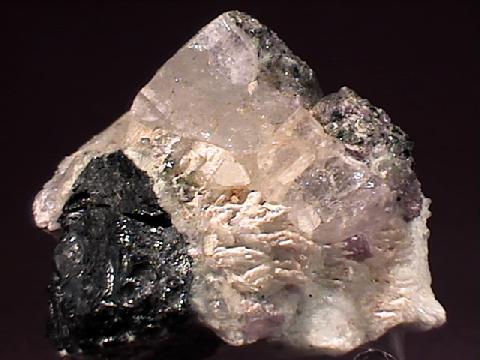
MORGANITE specimen mor-14
$ 45.00
$ 45.00
Dims: 2.4" x 2.2" x 1.7" (6.1 x 5.8 x 4.3 cm)
Wt: 5.40 oz. (153.2 g)
Stewart Mine, Pala, California, U.S.A.
This small hand specimen consists of a single, rather long Morganite crystal that is partially embedded in a pegmatite host. It has dimensions of 1.5 x 1.4 x 1.2", and is in moderate condition due to breakage. The entire specimen has been broken into 3 pieces that were then glued back together. This repair work is easily visible, though only through some close inspection. The Morganite crystal itself was broken in half through the breakage, and one can easily see the glue that was used to repair it. It's cross-section shows a noticeable hexagonal outline, though only one prism face is visible. The rest are either intergrown with the host rock, missing due to intergrowth with other adjacent formations, or covered by a tangle of tiny, partially intergrown elbaite crystals and lepidolite clusters. There is a small amount of one definable termiation at one end, but this is mostly intergrown with the host rock. The other end of the crystal shows a flat but slightly uneven basal breakage plane that may have undergone some subtle healing. The pegmatite host in which the Morganite rests is made up of albite that contains substantial amounts of broken lepidolite and elbaite crystals, and two large portions of a broken schorl.
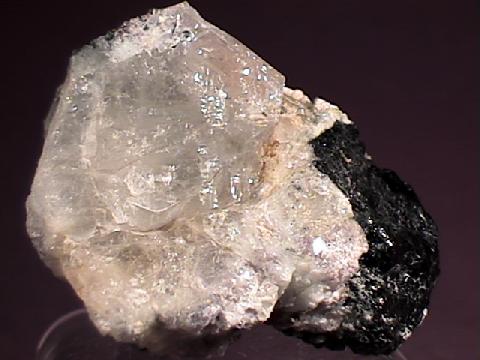

mor-14 ($ 45.00)
Stewart Mine, Pala, California, U.S.A.
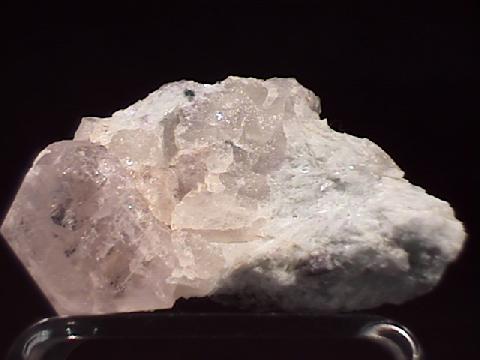
MORGANITE specimen mor-15
$ 220.00
$ 220.00
Dims: 2.4" x 1.4" x 0.9" (6.1 x 3.6 x 2.3 cm)
Wt: 1.78 oz. (50.5 g)
Stewart Mine, Pala, California, U.S.A.
A single hexagonal prismatic Morganite crystal lies partly embedded in the pegmatite host rock of this specimen. The crystal has dimensions of 1.0 x 0.9 x 0.7" (2.5 x 2.3 x 1.8 cm) and is in very good condition, showing only a small amount of human-induced damage. It shows excellent form and is capped by two basal termination faces which are truncated by secondary faces. The prism and secondary termination faces show a dull, pearly-to-waxy luster, whereas the basal faces show a much brighter, vitreous luster. The crystal has a pale pink coloration and is transparent, and though it shows some visible clarity, most of its interior is marred by the presence of intergrown albite and many internal fractures. The host rock contains primarily albite and quartz, but there is a noticeable amount of lepidolite present, too.
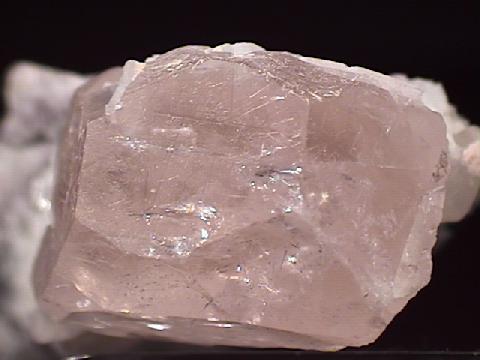

mor-15 ($220.00)
Stewart Mine, Pala, California, U.S.A.
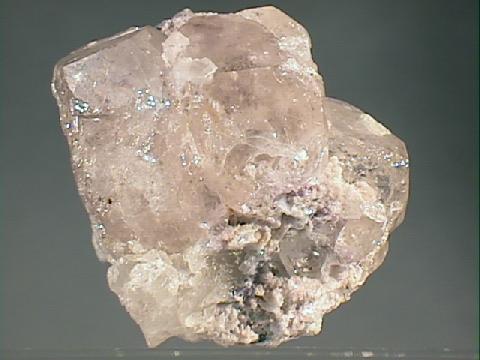
MORGANITE specimen mor-16
$ 200.00
$ 200.00
Dims: 1.8 x 1.7 x 1.5" (4.6 x 4.3 x 3.8 cm)
Wt: 3.27 oz. (92.7 g)
Stewart Mine, Pala, California, U.S.A.
At least 5 distinct Morganite crystals are embedded in the pegmatite host of this specimen. The largest has dimensions of 1.3 x 0.7 x 0.6" (3.2 x 1.8 x 1.6 cm). These crystals are in good condition- the two largest show considerable damage- and have excellent hexagonal tabular form with double basal terminations. All have a pale pink coloration and a pearly-to-vitreous luster; they are transparent and moderately clear, containing several internal fractures and a few cloudy inclusions. The pegmatite contains a few incomplete quartz crystals, a patch of crystalline lepidolite, and several partial elbaites.
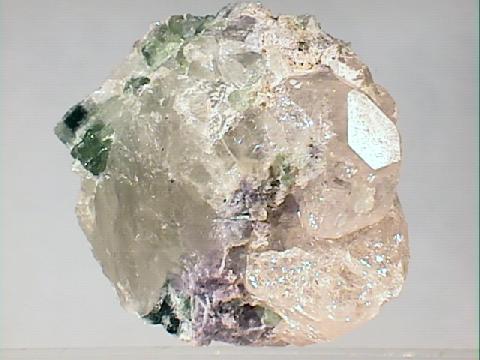

mor-16 ($200.00)
Stewart Mine, Pala, California, U.S.A.
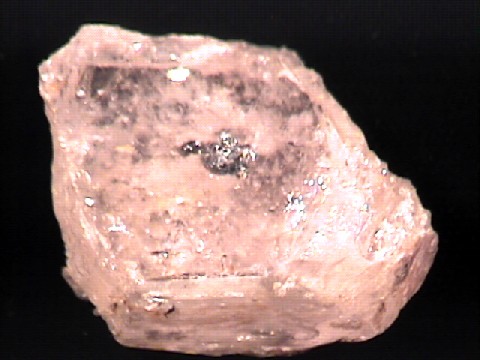
MORGANITE specimen mor-17
$ 90.00
$ 90.00
Dims: 1.22x0.98x0.71" (3.1x2.5x1.8cm)
Wt: 0.73oz (20.8g)
Pala, San Diego County, California, USA
This beryl crystal has just enough pink color to qualify as a morganite. It has a distorted 6-sided shape, and a very good basal termination. The crystal has several black inclusions, but the only significant one is several millimeters across, is black with a a metallic or vitrous luster, and is buried just beneath the center of the face of the morganite. I do not know what mineral it is, although it looks a bit like molybdenite, or possibly hematite. The morganite is transparent, although there are quite a few internal fractures, and the bottom and sides are mostly opaque due to the roughness of the surfaces. In addition to the transparent face of the crystal, one other side is smooth and undamaged, although it has a frosted appearance, and a fracture just beneath its surface renders it essentially opaque.
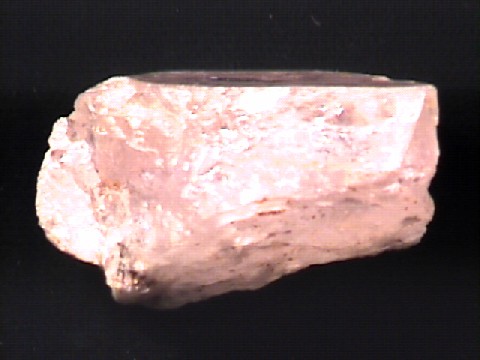

mor-17 ($ 90.00)
Pala, San Diego County, California, USA